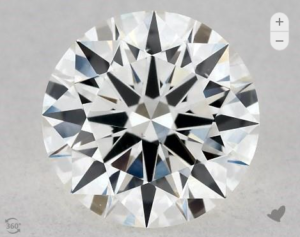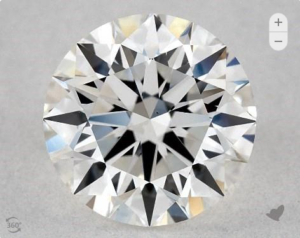This page contains references to diamonds or engagement rings from different companies. Sometimes I do receive a commission when you click on links and buy the products.
Sitting in the ‘near colorless’ category on the GIA diamond color scale, I color diamonds can be a wonderful way to maximise budget without compromising the bright white beauty that we covet in diamonds. A detailed understanding of diamond color and how it relates to your diamond buying decisions will allow you to avoid overspending and find the most beautiful diamond possible.
There are some considerations to make when choosing an I color diamond; fortunately, this guide will cover all of them.
What is an I Colored Diamond?
The ‘near colorless’ category may not sound particularly reassuring to first time buyers and diamond novices. The good news is that very few people can identify yellow tones in an I color diamonds, and even less can specifically identify a diamond color grade. Only skilled gemmologists using optimum lighting conditions can differentiate between the high color grades.
 Image Courtesy of Whiteflash
Image Courtesy of Whiteflash
With that said, I have experienced customers who are particularly sensitive to diamond color, and an I grade tends to be the tipping point for identifying yellow tones in the body of a diamond. The best way to tell how readily you perceive color is by observing diamonds using high res diamond imaging – we will take a closer look at this shortly.
For an overview of diamond color I recommend reading my full guide to diamond color.
Do I Colored Diamonds Look Yellow?
Generally speaking, yellow tints in an I color diamonds are difficult to detect. I have recommended many, beautiful I color diamonds, and in context, they offer a bright white appearance and very happy customers. However, unlike higher color graded diamonds, the other quality factors of an I color diamond can have an impact upon how white the diamond appears.
How to Make an I Color Diamond Look Whiter
I work with real customers and real budgets. Sometimes, those budgets mean the top color grades do not offer the best value, but this does not mean that beauty has to be compromised. In fact, dropping down on the color is the most practical way to make the most of a modest budget but can still yield fantastic results. Consider the other quality factors of the diamond and its context:
- Cut: I hammer home the important of a quality cut for good reason. With the facets working at the highest possible level, light is bounced and reflected throughout the diamond and back to the viewer. A good cut can hide a multitude of ‘sins’, including any yellowish tints the diamond may possess. If you haven’t considered the option of a super-ideal cut diamond, now is the time to do so. Not only will this result in a more sparkly, better looking diamond, it can also go a long way towards concealing color.
- Shape: Round brilliants are highly adept at concealing color. Other cuts will present color more readily. For step cuts such as emerald or Asscher, a higher grade may be necessary – this is not a hard and fast rule, but it is something to consider alongside the other factors.
- Setting: Warmer tone metals such as yellow and rose gold can help a diamond appear whiter. The rich tones of these metals can also be highly flattering and are a wonderful choice for engagement rings.
- Angle: Diamonds present color more readily when viewed side on (as opposed to top-down through the table). If you use high-res, 360 imaging to view a loose diamond, remember that the diamond will be set in a ring and viewed from the top.
- In a ring: Remember that while close scrutiny is a crucial part of the diamond buying process, the diamond will be set in a ring a viewed under normal lighting conditions. Large inclusions and a poor cut cannot be disguised by settings or lighting conditions, but a very subtle, yellow hint will be barely noticeable when set and observed in every day circumstances. Providing the cut is exquisite, the diamond can still dazzle admirers.
Choosing an I Color Diamond
Here is your tick-list for choosing an I color diamond that is guaranteed to deliver:
- Look for diamonds with AGS or GIA reports. Only these leading labs offer reliable and consistent grades that guarantee you are getting what’s on the certificate.
- Choose from vendors who provide high-res diamond imaging so you can scrutinize the diamond before buying.
- Go for the best possible cut; in particular, consider ideal-cut diamonds.
- Consider the diamond color in context with other quality factors and the chosen setting.
I Color Diamond Prices
Diamond prices change rapidly and are influenced by multiple factors. However, as a brief case study, observe the diamonds pictured below:

 Images Courtesy of James Allen
Images Courtesy of James Allen
These diamonds are both 1.02ct VS2 round brilliant diamonds with the same cut grade. The diamond on the top is an I, the diamond below it is an F. The price difference is over $3,000 – while the visual difference is negligible, the price difference is not.
The Final Word

Richard Jenkins, The Diamond Guru
Get free assistance from the Diamond Guru today. You’ll be glad you did!
- Secure the best quality diamond for your budget.
- Don’t pay over the odds for your diamond ring.
- Have peace of mind that you didn’t get ripped off.
Have a Question? Contact us now…

